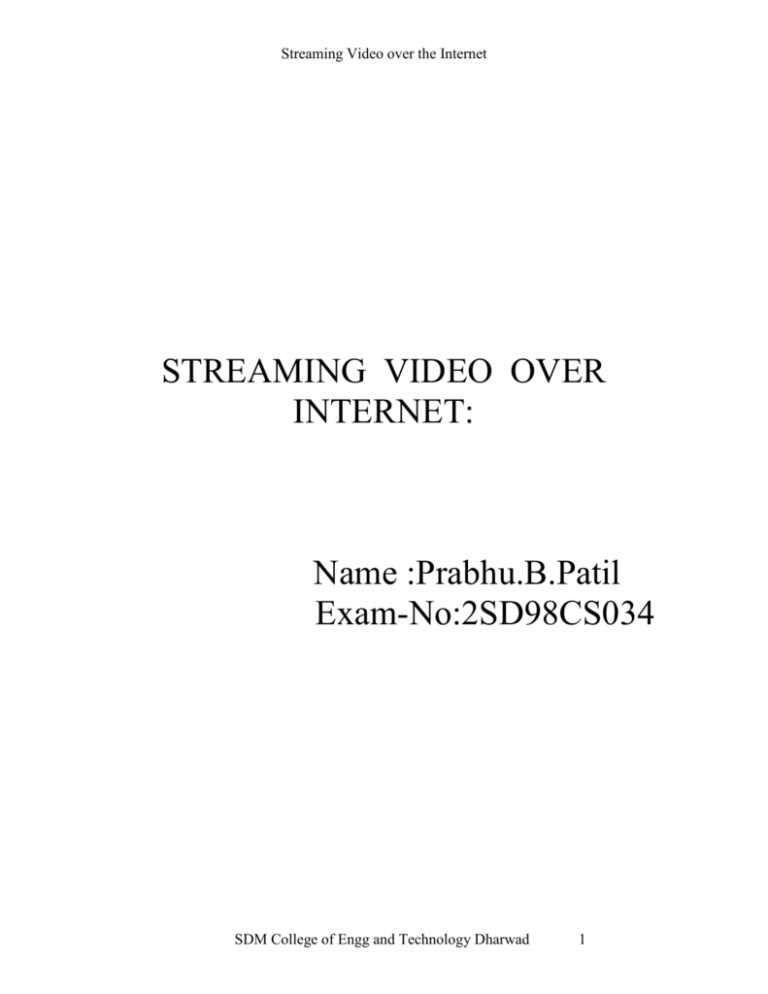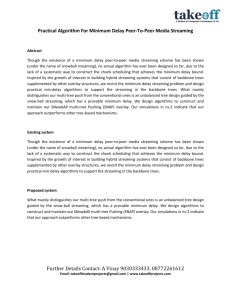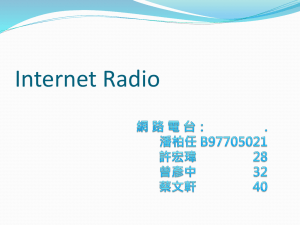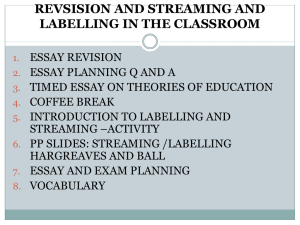STREAMING VIDEO OVER INTERNET:
advertisement

Streaming Video over the Internet STREAMING VIDEO OVER INTERNET: Name :Prabhu.B.Patil Exam-No:2SD98CS034 SDM College of Engg and Technology Dharwad 1 Streaming Video over the Internet 1.Abstract Advances in computing technology , compression technology , high bandwidth storage devices and high-speed networks have made it feasible to provide real-time multimedia services over the network .Realtime multimedia has timing constraints ,for example audio and video data must be simultaneously played out . Otherwise process will pause. Real-time transport of live video or stored video is the predominant part of real-time multimedia . In this we are concerned with video streaming which refers to real-time stored video . There are two modes of transmission of stored video namely , Download mode and Streaming mode(video streaming) . In case of download mode the entire video is downloaded first and then plays back the video file streaming mode streaming mode ,the . In case of video content is need not be downloaded in full , but is played out while parts of the content are being received and decoded . Due to the real-time nature the video streaming typically has band-width, delay and loss requirements .It is difficult to meet the wide range of QoS requirements from users . Thus the designing mechanisms and protocols for Internet streaming video poses many challenges . Six key areas of video streaming are Video Compression , Application-layer QoS control , Continuous media distribution services , Streaming servers , Media synchronization mechanisms and Protocols for streaming media . SDM College of Engg and Technology Dharwad 2 Streaming Video over the Internet 2. Architecture of Video Streaming The raw video and audio data are pre-compressed by video compression and audio compression algorithms . and saved in storage devices .Upon the client’s request a streaming server retrieves compressed audio/video data from storage devices and then application- layer QoS control adapts the video/audio bit-streams according to network status and QoS requirements . Then transport protocols packetize the compressed bistreams and send over the Internet . Packets may experience the excessive delay , due to the Congestion . To improve the quality of transmission continuous media distribution services ( eg Caching) are deployed in the Internet. SDM College of Engg and Technology Dharwad 3 Streaming Video over the Internet 3. Video Compression Raw video must be compressed before transmission to achieve efficiency. Video compression schemes can be classified into two categories: Scalable and non-scalable video coding. Since scalable video is capable of gracefully coping with the bandwidth fluctuations in the Internet , we are primarily concerned with scalable video coding techniques. We will also discuss the requirements imposed by streaming applications on the video encoder and decoder. Non scalable video encoder generates the one compressed bit-stream . In contrast , a scalable video encoder compresses the raw video into multiple sub-streams , a base sub-stream and a enhancement sub-stream . The complete bit stream is the combination of the two sub-streams . providing highest quality . SDM College of Engg and Technology Dharwad 4 Streaming Video over the Internet Next, we describe various requirements imposed by streaming applications on the video encoder and decoder and discuss some techniques that address these requirements. Bandwidth. : To achieve acceptable perceptual quality, streaming application typically has minimum bandwidth requirement. In addition, it is desirable for video streaming applications to employ congestion control to avoid congestion, which happens when the network is heavily loaded. Compared with non-scalable video, scalable video is adaptable to the varying available bandwidth in the network. Delay. Streaming video requires bounded end-to-end delay so that packets can arrive at the receiver in time to be decoded and displayed. If a video packet does not arrive in time, the playout process will pause, which is annoying to human eyes.. Since the Internet introduces time-varying delay, to provide continuous playout, a buffer at the receiver is usually introduced before decoding. Loss. Packet loss is inevitable in the Internet and packet loss can damage pictures, which is displeasing to human eyes. Thus, it is desirable that a video stream be robust to packet loss. Multiple description coding is such a compression technique to deal with packet loss . Video-cassette-recorder (VCR) like function. Some streaming applications require VCR-like functions such as stop, pause/resume, fast forward, fast backward and random access. SDM College of Engg and Technology Dharwad 5 Streaming Video over the Internet 4.Application-Layer QoS Control To cope with varying network conditions and diferent presentation quality requested by the users, various application-layer QoS control techniques have been proposed .The application-layer techniques include congestion control and error control. Their respective functions are as follows. Congestion control is employed to prevent packet loss and reduce delay. Error control, on the other hand, is to improve video presentation quality in the presence of packet loss. Error control mechanisms include forward error correction (FEC), retransmission, error-resilient encoding and error concealment. A. Congestion Control: Congestion control mechanisms at end systems are necessary to help reducing packet loss and delay. Typically, for streaming video, congestion control takes the form of rate control . Rate control attempts to minimize the possibility of network congestion by matching the rate of the video stream to the available network bandwidth. Rate Control: Rate control is a technique used to determine the sending rate of video traffic based on the estimated available band-width in the network. Existing rate control schemes can be classified in to : source-based , receiver-based and hybrid rate control . Under source-based rate control the sender is responsible for adapting the video transmission rate . It can be applied to unicast or multicast .Under the receiver-based rate control the receiver regulates the rate while sender does not participate in rate control . Under Hybrid-rate SDM College of Engg and Technology Dharwad 6 Streaming Video over the Internet control , the receiver regulates the receiving rate and sender adjusts the transmission rate . B . Error Control : Error control mechanisms include FEC , retransmission , error-resilient encoding and error concealment . FEC : The principle of FEC is to add redundant information so that original message can be reconstructed in the presence of packet loss. Based on the kind of redundant information to be added, we classify existing FEC schemes into three categories: channel coding, source coding-based FEC, and joint source/channel coding . For Internet applications, channel coding is typically used in terms of block codes. Specifically, a video stream is first chopped into segments, each of which is packetized into k packets; then for each segment, a block code is applied to the k packets to generate an n-packet block, where n > k. To perfectly recover a segment, a user only needs to receive any k packets in the n-packet block. Source coding-based FEC (SFEC) is a recently devised variant of FEC for Internet video .Like channel coding, SFEC also adds redundant information to recover from loss. Delay-constrained Retransmission: Retransmission is usually dismissed as a method to recover lost packets in real-time video since a retransmitted packet may miss its play-out time. However, if the oneway trip time is short with respect to the maximum allowable delay, a retransmission-based approach (called delay-constrained retransmission) is a viable option for error control. For unicast, the receiver can perform the following delay-constrained retransmission scheme. Error-resilient Encoding: The objective of error- resilient encoding is to enhance robustness of compressed video to packet SDM College of Engg and Technology Dharwad 7 Streaming Video over the Internet loss. The standardized error-resilient encoding schemes include resynchronization marking, data partitioning, and data recovery point in the variable-length On Since a packet loss may cause the loss of all the motion data and its associated shape/texture data, mechanisms such as resynchronization marking, data partitioning, and data recovery may not be useful for Internet video applications. multiple description coding (MDC) which is promising for robust Internet video transmission. MDC provides robustness to loss and enhanced quality . Error Concealment: Error-resilient encoding is executed by the source to enhance robustness of compressed video before packet loss actually happens (this is called preventive approach). On the other hand, error concealment is performed by the receiver when packet loss has already occurred (this is called reactive approach). Specifically, error concealment is employed by the receiver to conceal the lost data and make the presentation less displeasing to human eyes. There are two basic approaches for error concealment, namely, spatial and temporal interpolation. In spatial interpolation, missing pixel values are reconstructed using neighboring spatial information. In temporal interpolation, the lost data is reconstructed from data in the previous frames. Typically, spatial interpolation is used to reconstruct the missing data in intra-coded frames while temporal interpolation is used to reconstruct the missing data in inter-coded frames . SDM College of Engg and Technology Dharwad 8 Streaming Video over the Internet 5. Continuous Media Distribution Services. In order to provide quality multimedia presentations, adequate network support is crucial. This is because network support can reduce transport delay and packet loss ratio. Built on top of the Internet (IP protocol), continuous media distribution services are able to achieve QoS and efficiency for streaming video/audio over the best-effort Internet. Continuous media distribution services include network filtering, application-level multicast, and content replication. Caching :- which is based on the belief that different clients will load many of the same contents, makes local copies of contents that the clients retrieve. SDM College of Engg and Technology Dharwad 9 Streaming Video over the Internet Typically,clients in a single organization retrieve all contents from a single local machine, called a cache. The cache retrieves a video _le from the origin server, storing a copy locally and then passing it on to the client who requests it. If a client asks for a video _le which the cache has already stored, the cache will return the local copy rather than going all the way to the origin server where the video _le resides. In addition, cache sharing and cache hierarchies allow each cache to access _les stored at other caches so that the load on the origin server can be reduced and network bottlenecks can be alleviated . SDM College of Engg and Technology Dharwad 10 Streaming Video over the Internet 6. Streaming Servers Streaming servers play a key role in providing streaming services. To offer quality streaming services, streaming servers are required to process multimedia data under timing constraints in order to prevent artifacts (e.g., jerkiness in video motion and pops in audio) during playback at the clients. In addition, streaming servers also need to support VCR-like control operations such as stop, pause/resume, fast forward and fast backward. Furthermore, streaming servers have to retrieve media components in a synchronous fashion. For example, retrieving a lecture presentation requires synchronizing video and audio with lecture slides. A streaming server typically consists of the following three subsystems. Communicator. : A communicator involves the application layer and transport protocols implemented on the server. Through a communicator, the clients can communicate with a server and retrieve multi-media contents in a continuous and synchronous manner. . Operating system : Different from traditional operating systems, an operating system for streaming services needs to satisfy real-time requirements for streaming applications. Storage system. : A storage system for streaming services has to support continuous media storage and retrieval. SDM College of Engg and Technology Dharwad 11 Streaming Video over the Internet Real-time Operating system : . Process management : resource management file management Storage system : High throughput , fault tolerance , large capacity . Increased throughput with datastripping Increased capacity with hierarchical storage . SDM College of Engg and Technology Dharwad 12 Streaming Video over the Internet 7. Media Synchronization Media synchronization is a major feature that distinguishes multimedia applications from other traditional data applications. With media synchronization mechanisms, the application at the receiver side can present various media streams in the same way as they were originally captured. An example of media synchronization is that the movements of a speaker's lips match the played-out audio. Media synchronization refers to maintaining the temporal relationships within one data stream and between various media streams. There are three levels of synchronization, namely, intra-stream, inter-stream and inter-object synchronization. 1. Intra-stream synchronization. The lowest layer of continuous media or time-dependent data (such as video and audio) is the media layer. The unit of the media layer is logical data unit such as a video/audio frame, which adheres to strict temporal constraints to ensure acceptable user perception at playback. Synchronization at this layer is referred to as intra-stream synchronization, which maintains the continuity of logical data units. Without intra-stream synchronization, the presentation of the stream may be interrupted by pauses or gaps. 2. Inter-stream synchronization. The second layer of time-dependent data is the stream layer. The unit of the stream layer is a whole stream. Synchronization at this layer is referred to as inter-stream synchronization, SDM College of Engg and Technology Dharwad 13 Streaming Video over the Internet which maintains temporal relationships among different continuous media. Without inter-stream synchronization, skew between the streams may become intolerable. For example, users could be annoyed if they notice that the movements of the lips of a speaker do not correspond to the presented audio. 3. Inter-object synchronization. The highest layer of a multimedia document is the object layer, which integrates streams and time-independent data such as text and still images. Synchronization at this layer is referred to as inter-object synchronization. The objective of inter-object synchronization is to start and stop the presentation of the time-independent data within a tolerable time interval, if some previously de_ned points of the presentation of a time-dependent media object are reached. Without interobject synchronization, for example, the audience of a slide show could be annoyed if the audio is commenting one slide while another slide is being presented. SDM College of Engg and Technology Dharwad 14 Streaming Video over the Internet 8. Protocols for Streaming Video Protocols are designed and standardized for communication between clients and streaming servers. Protocols for streaming media provide such services as network addressing, transport, and session control. According to their functionalities, the protocols can be classified into three categories: network-layer protocol such as Internet protocol (IP), transport protocol such as user datagram protocol (UDP), and session control protocol such as real-time streaming protocol (RTSP). SDM College of Engg and Technology Dharwad 15 Streaming Video over the Internet 1. Network –layer protocol : It provides basic network service support such as network addressing. The Internet protocol (IP) serves as the network-layer protocol for Internet video streaming. 2. Transport protocol. It provides end-to-end network transport functions for streaming applications. Transport protocols include UDP, TCP, real-time transport protocol (RTP), and real-time control protocol (RTCP). UDP and TCP are lower-layer transport protocols while RTP and RTCP are upper-layer transport protocols, which are implemented on top of UDP/TCP 3. Session control protocol. It defines the messages and procedures to control the delivery of the multimedia data during an established session. The real-time streaming protocol (RTSP) and the session initiation protocol (SIP) are such session control protocols. SDM College of Engg and Technology Dharwad 16 Streaming Video over the Internet Conclusion Video streaming is an important component of many Internet multimedia applications, such as distance learning, digital libraries, home shopping and video-on-demand. The best-effort nature of the current Internet poses many challenges to the design of streaming video systems. we have surveyed major approaches and mechanisms for Internet video streaming. The objective is not to provide an exhaustive review of existing approaches and mechanisms, but instead to give a perspective on the range of options available and the associated trade-offs among performance, functionality, and complexity. Bibliography : IEEE TRANSACTIONS ON CIRCUITS AND SYSTEMS FOR VIDEO TECHNOLOGY, VOL. 11, NO. 1, FEBRUARY 2001 RFC 1890 ( RTP for audio/video ) SDM College of Engg and Technology Dharwad 17





